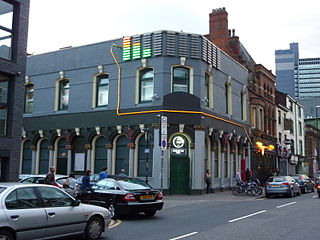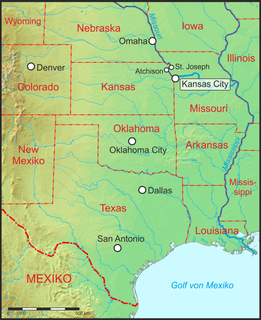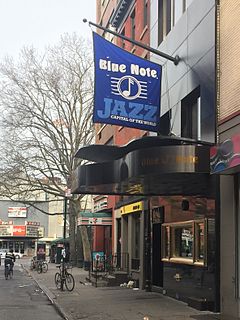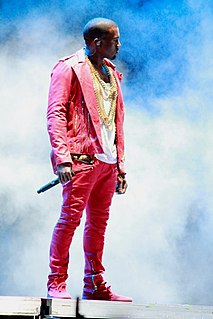
A jazz band is a musical ensemble that plays jazz music. Jazz bands vary in the quantity of its members and the style of jazz that they play but it is common to find a jazz band made up of a rhythm section and a horn section.

A big band or jazz orchestra is a type of musical ensemble of jazz music that usually consists of ten or more musicians with four sections: saxophones, trumpets, trombones, and a rhythm section. Big bands originated during the early 1910s and dominated jazz in the early 1940s when swing was most popular. The term "big band" is also used to describe a genre of music, although this was not the only style of music played by big bands.
Swing music is a style of jazz that developed in the United States during the late 1920s and early 1930s. It became nationally popular from the mid-1930s. The name derived from its emphasis on the off-beat, or nominally weaker beat. Swing bands usually featured soloists who would improvise on the melody over the arrangement. The danceable swing style of big bands and bandleaders such as Benny Goodman was the dominant form of American popular music from 1935 to 1946, known as the swing era. The verb "to swing" is also used as a term of praise for playing that has a strong groove or drive. Musicians of the swing era include Duke Ellington, Benny Goodman, Count Basie, Cab Calloway, Jimmy Dorsey, Tommy Dorsey, Woody Herman, Harry James, Lionel Hampton, Glenn Miller, Artie Shaw and Django Reinhardt.

Edward Lee Morgan was an American jazz trumpeter and composer.
Virginia's musical contribution to American culture has been diverse, and includes Piedmont blues, jazz, folk, brass, hip-hop, and rock and roll bands, as well as the founding origins of country music in the Bristol sessions by Appalachian Virginians.

Tim Hagans is an American jazz trumpeter, arranger, and composer. He has been nominated for three Grammy Awards: Best Instrumental Composition for "Box of Cannoli" on The Avatar Sessions ; Best Contemporary Jazz Album for Animation*Imagination ; and Best Contemporary Jazz Album for Re-Animation.

The 100 Club is a music venue located at 100 Oxford Street, London, England, where it has been hosting live music since 24 October 1942. It was originally called the Feldman Swing Club, but changed its name when the father of the current owner took over in 1964.

Jazz music has a long history in Australia. Over the years jazz has held a high-profile at local clubs, festivals and other music venues and a vast number of recordings have been produced by Australian jazz musicians, many of whom have gone on to gain a high profile in the international jazz arena.

Band on the Wall is a live music venue in the Northern Quarter of Manchester, England.

The Great American Music Hall is a concert hall in San Francisco, California. It is located on O'Farrell Street in the Tenderloin neighborhood on the same block as the Mitchell Brothers O'Farrell Theatre. It is known for its decorative balconies, columns, and frescoes and for its history of unique entertainment, which has included burlesque dancing as well as jazz, folk music, and rock and roll concerts. The capacity of the hall is 470 people.

The Roseland Ballroom was a multipurpose hall, in a converted ice skating rink, with a colorful ballroom dancing pedigree, in New York City's theater district, on West 52nd Street in Manhattan.

Kansas City jazz is a style of jazz that developed in Kansas City, Missouri during the 1920s and 1930s, which marked the transition from the structured big band style to the much more improvisational style of bebop. The hard-swinging, bluesy transition style is bracketed by Count Basie, who in 1929 signed with the Bennie Moten's Kansas City Orchestra, and Kansas City native Charlie Parker, who ushered in the bebop style in America. It has been said that while New Orleans was the birthplace of jazz, "America's music" grew up in Kansas City.

Blue Note Jazz Club is a jazz club and restaurant located at 131 West 3rd Street in Greenwich Village, New York City. The club was opened on September 30, 1981, by owner and founder Danny Bensusan, with the Nat Adderley Quintet being the featured performers for the night. The club's performance schedule features shows every evening at 8:00 pm and 10:30 pm and a Sunday jazz brunch with performances at 12:30 pm and 2:30 pm. The venue has also started a bi-weekly Late Night Groove Series giving New York's up-and-coming jazz, soul, hip-hop, R&B and funk artists an opportunity to showcase their talents on Saturday and Sunday mornings at 12:30 am. The club has locations in Tokyo and Nagoya, Japan; Milan, Italy; Waikiki, Hawaii; Napa, California; Beijing, China; and São Paulo, Brazil.

A jazz club is a venue where the primary entertainment is the performance of live jazz music, although some jazz clubs primarily focus on the study and/or promotion of jazz-music. Jazz clubs are usually a type of nightclub or bar, which is licensed to sell alcoholic beverages. Jazz clubs were in large rooms in the eras of Orchestral jazz and big band jazz, when bands were large and often augmented by a string section. Large rooms were also more common in the Swing era, because at that time, jazz was popular as a dance music, so the dancers needed space to move. With the transition to 1940s-era styles like Bebop and later styles such as soul jazz, small combos of musicians such as quartets and trios were mostly used, and the music became more of a music to listen to, rather than a form of dance music. As a result, smaller clubs with small stages became practical.

Chicago, Illinois is a major center for music in the midwestern United States where distinctive forms of blues, and house music, a genre of electronic dance music, were developed.

Brent Christopher Gallaher is an American jazz saxophonist and composer.

The Flamingo Club was a jazz nightclub in Soho, London, between 1952 and 1969. It was located at 33–37 Wardour Street from 1957 onwards and played an important role in the development of British rhythm and blues and modern jazz. During the 1960s, the Flamingo was one of the first clubs to employ fully amplified stage sound and used sound systems provided by ska musicians from the Caribbean. The club had a wide social appeal and was a favourite haunt for musicians, including The Who.

The history of jazz in Belgium starts with the Dinant instrument maker Adolphe Sax, whose saxophone became part of military bands in New Orleans around 1900 and would develop into the jazz instrument par excellence. From then on the early history of jazz in Belgium virtually runs parallel to developments in the country of the birth of jazz, from the minstrel shows in the late 19th century until the first Belgian jazz album in 1927 and beyond.
John Von Ohlen was an American jazz drummer who worked for Woody Herman in 1967 and 1969, then with Stan Kenton from 1970 to 1972. He began playing Trombone in middle school, and played through high school. He graduated from North Central High School in 1960. He then went to North Texas State briefly, but returned to Indianapolis shortly after.
Blue Wisp Big Band was founded in 1980 by drummer John Von Ohlen and trumpeter Don Johnson. The band took its name from the Blue Wisp Jazz Club.
















